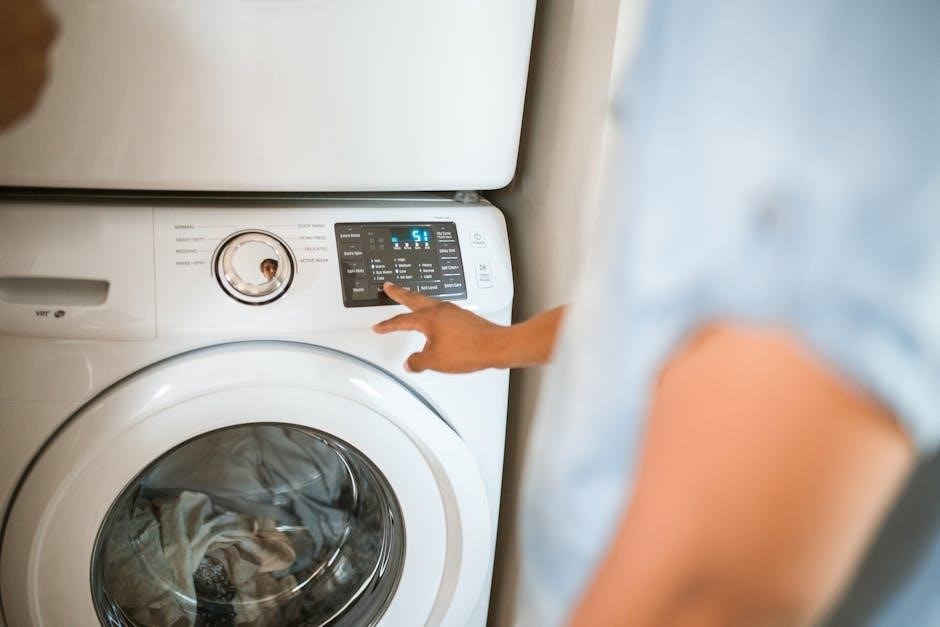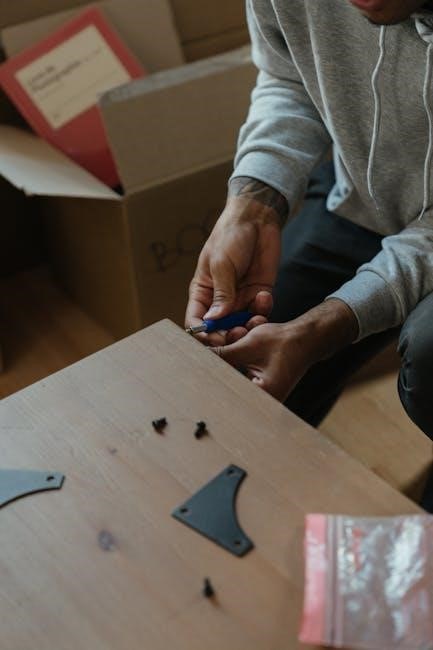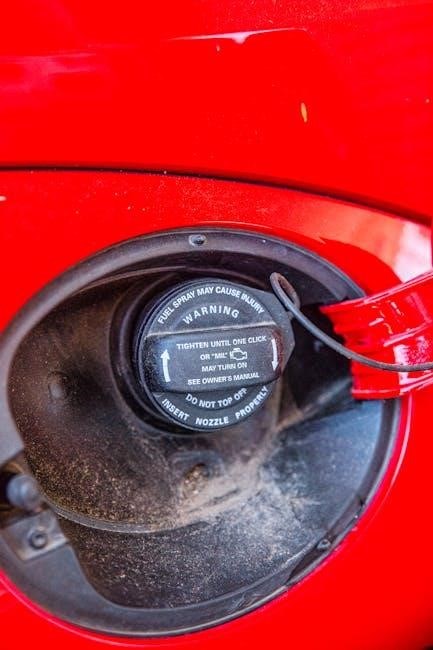Apivar strips are a highly effective treatment for controlling Varroa mites in bee colonies․ These amitraz-impregnated strips are easy to apply and provide long-lasting protection for bees․
1․1 What Are Apivar Strips?
Apivar strips are ready-to-use, amitraz-impregnated plastic strips designed to control Varroa mites in honeybee colonies․ They are simple to apply and work through contact with bees, distributing the active ingredient effectively․ These strips are specifically formulated to target Varroa mites, helping to reduce infestations and protect hive health․ Apivar strips are typically placed in the brood chamber, where they remain for a minimum of 6 weeks to ensure optimal effectiveness․ They are a popular choice among beekeepers due to their ease of use and proven efficacy in mite control․
1․2 Importance of Apivar in Beekeeping
Apivar strips play a crucial role in maintaining the health of bee colonies by effectively controlling Varroa mite infestations, a major threat to honeybees․ Their ability to distribute amitraz through bee contact ensures comprehensive protection without harming the colony․ Beekeepers rely on Apivar for its ease of use and high efficacy, making it a vital tool in preventing mite-related diseases and colony decline․ Regular application of Apivar strips helps sustain healthy bee populations, which are essential for pollination and honey production․ This treatment is a cornerstone of modern beekeeping practices worldwide․

Key Rules for Effective Treatment
Apivar strips must be used without temperature constraints, applied for at least 6 weeks, and never reused to ensure optimal Varroa mite control and bee health․
2․1 No Temperature Constraints for Use
Apivar strips can be used regardless of temperature, making them versatile for various climates․ This flexibility ensures consistent Varroa mite control without weather-related delays․ Simply follow the recommended six-week treatment duration for optimal results․ The lack of temperature restrictions simplifies treatment planning, allowing beekeepers to apply strips whenever needed․ Always ensure strips are applied correctly and left undisturbed for the full treatment period․ This feature enhances the product’s practicality and effectiveness in managing Varroa infestations across different environmental conditions․
2․2 Minimum Duration of Use (6 Weeks)
The minimum treatment duration with Apivar strips is six weeks to ensure effective Varroa mite control․ This extended period allows the active ingredient to disrupt the mite’s life cycle fully․ Removing the strips earlier may leave a significant number of mites alive, reducing treatment efficacy․ It’s crucial to adhere to this timeline to prevent reinfestation and maintain the health of the bee colony․ Consistently following this guideline helps achieve optimal results and prevents the development of resistance․
2․3 Avoid Reusing Strips
Reusing Apivar strips is not recommended due to the depletion of the active ingredient over time․ Once exposed to bees, the strip’s potency decreases, reducing its effectiveness against Varroa mites․ Reusing strips can lead to under-dosing, which may result in incomplete mite control and potential resistance issues․ Additionally, reused strips may accumulate debris or contaminants, further compromising their efficacy․ Always use fresh strips for each treatment to ensure optimal results and maintain bee health․ This practice is critical for achieving long-term Varroa management and preventing treatment failures․
2;4 Proper Removal After Treatment
After the treatment period, remove Apivar strips carefully to prevent contamination and ensure hive health․ Wait until the recommended duration has elapsed before taking out the strips․ Handle them gently to avoid breaking, as this could release residual chemicals․ Dispose of used strips according to local regulations, treating them as agricultural waste․ Do not clean or reuse the strips, as this can compromise their effectiveness․ Proper removal helps maintain a clean hive environment and prevents any lingering chemical residue from affecting the bees or hive products․

How to Use Apivar Strips: Step-by-Step
Start by removing the strips from their packaging and separating them as needed․ Handle strips carefully, avoiding contact with the active ingredients․ Place them in the hive, ensuring proper positioning for optimal effectiveness․ Follow all safety precautions and complete the application process promptly to minimize disruption to the bees․ Wash hands thoroughly after handling the strips․
3․1 Separating the Double Rigid Strips
Apivar strips are often provided as double rigid strips connected at one end․ To separate them, gently bend the strip at the connecting point until it breaks cleanly; Handle the strips by the edges to avoid exposure to the active ingredient․ Ensure each strip is intact and free from damage during separation․ This step is crucial for proper placement and effectiveness in the hive․ Avoid using tools or force that might damage the strips․ Proper separation ensures each strip functions independently, maximizing treatment efficacy․
3․2 Using the Die-Cut Triangle as Hanging Hooks
The die-cut triangle on the Apivar strip serves as a convenient hanging hook․ To use it, locate the triangular notch at the top of the strip․ This notch is designed to fit securely between the hive frames․ Gently slide the triangle between two frames, ensuring it rests evenly without causing pressure on the bees․ This method allows the strip to hang freely, exposing both sides to bee activity․ Proper alignment ensures the strip remains in place, facilitating even distribution of the treatment within the hive;
3․3 Placement in the Brood Chamber
Place the Apivar strip vertically in the brood chamber, ensuring it is positioned between frames where bee activity is highest․ This location maximizes exposure to the treatment, as bees will naturally walk on the strip․ Avoid obstructing the bees’ movement or placing the strip too close to the hive walls․ Proper placement ensures even distribution of the active ingredient and prevents contamination of honey supers․ Always position the strip in the brood chamber, as this is where Varroa mites are most active and where treatment is most effective․ Ensure the strip is securely hung to avoid shifting during bee activity․
3․4 Positioning in High Bee Activity Areas
Position Apivar strips in areas with high bee traffic to maximize treatment effectiveness․ Ideally, place strips near the brood nest or where foragers are most active․ This ensures frequent contact between bees and the treatment strip․ Avoid areas with low bee activity, as this may reduce the product’s efficacy․ Proper positioning allows bees to walk on the strip, distributing the active ingredient effectively throughout the colony․ Ensure the strip is easily accessible to the bees without obstructing their natural movement or foraging patterns․
3․5 Ensuring Bees Can Walk on Both Sides
To maximize the effectiveness of Apivar strips, ensure bees can access both sides of the strip․ This allows for even distribution of the active ingredient and prevents overcrowding․ Position the strip so it does not obstruct bee movement or block hive frames․ Secure the strip firmly to avoid shifting, which could restrict access․ Regularly inspect the hive to ensure bees are freely walking on both sides of the strip․ Proper placement enhances treatment efficacy and supports colony health․

When to Use Apivar Strips
Apivar strips are best used in spring before nectar collection and in autumn after harvesting․ Avoid application during supers placement to prevent contamination of honey products․
4․1 Spring Application (Before Nectar Collection)
Spring is an ideal time to use Apivar strips, as it targets Varroa mites before they multiply and before nectar collection begins․ Applying the strips early ensures the colony is healthy during the critical growth phase․ This timing also prevents mite populations from exploding during summer․ Additionally, treating before nectar collection helps avoid contamination of honey products, ensuring food safety and maintaining hive health․ Always follow the product instructions for optimal results and to protect your bees effectively․
4․2 Autumn Application (After Harvesting)
Autumn is a critical time for Apivar strip application, as it helps reduce Varroa mite populations before winter․ Treating after harvesting ensures honey supers are removed, preventing contamination․ This timing also prepares the colony for winter by minimizing mite loads, which can weaken bees during colder months․ Follow product instructions carefully to ensure optimal efficacy and protect your bees from potential mite-related issues heading into winter․
4․3 Avoiding Use During Supers Placement
Apivar strips should not be used during supers placement, as the active ingredients can transfer to honey, potentially causing contamination․ This ensures the safety and quality of honey for human consumption․ Beekeepers must wait until supers are removed after harvesting to apply the strips․ Always follow the recommended treatment duration and timing to avoid any residue in honey․ This precaution is crucial for maintaining both honey quality and effective mite control․
Placement and Positioning
Proper placement ensures Apivar strips effectively target varroa mites․ Hang strips between frames in high bee activity areas, positioning them securely to allow bees to walk freely․
5․1 Hanging Strips Between Frames
Hang Apivar strips securely between frames in the brood chamber, using the die-cut triangle as a hook․ Position strips near the brood nest for optimal mite exposure․ Ensure the strips are evenly spaced and maintained vertically to allow bees to move freely․ Proper placement maximizes the strips’ efficacy in controlling varroa infestations․ Avoid overcrowding frames to prevent interference with bee activity․ This method ensures effective treatment while minimizing disruptions to the colony’s natural behavior and hive operations․
5․2 Maintaining Minimum Distance Between Strips
Maintain a minimum distance of approximately 5-7 centimeters between Apivar strips to ensure even distribution of the active ingredient․ Proper spacing prevents overcrowding and allows bees to move freely around the strips․ This distance also maximizes the treatment’s efficacy by ensuring the medication diffuses uniformly throughout the hive․ Avoid clustering strips too closely, as this can reduce airflow and hinder the product’s performance․ Consistent spacing supports optimal varroa mite control and minimizes potential disruptions to the colony’s health and productivity․
5․4 Using the Pop-Up Triangular Tag
The pop-up triangular tag attached to Apivar strips serves as a convenient marker․ To use it, simply detach the tag from the strip and attach it to the hive frame or box near the strips․ This helps in identifying treated colonies and ensures easy monitoring․ The tag remains visible throughout the treatment period, aiding in tracking the duration of use․ While it does not affect the product’s efficacy, it provides a practical way to keep records and ensure compliance with treatment schedules․ Proper placement enhances organization and monitoring efficiency․

Duration of Treatment
The treatment duration for Apivar strips is a minimum of six weeks․ This ensures optimal efficacy against varroa mites and supports colony health․ Consistency is key․
6․1 Leaving Strips for At Least 6 Weeks
Apivar strips must remain in the hive for a minimum of six weeks to ensure full efficacy․ This duration allows the active ingredient, Amitraz, to effectively target varroa mites and their eggs․ Removing the strips earlier may reduce treatment effectiveness and leave the colony vulnerable․ Consistent exposure over six weeks maximizes mite control and supports the health of the bee population․ Always adhere to this timeframe for optimal results and to prevent resistance development․
6․2 Timing for Optimal Efficacy
Apivar strips work best when applied during periods of high varroa mite activity, typically in spring or autumn․ Spring treatment ensures mites are controlled before the nectar flow, while autumn application targets mites before winter․ Proper timing maximizes the product’s effectiveness, ensuring a healthy bee colony․ Always align treatment with seasonal beekeeping practices to achieve optimal mite control and protect hive health throughout the year․

Enhancing Apivar’s Efficacy
- Treat all colonies simultaneously to prevent mite migration․
- Ensure proper strip placement and dosage for maximum effect․
- Target varroa breeding areas to optimize mite control․
7․1 Treating All Colonies Simultaneously
Treating all colonies at the same time prevents varroa mites from migrating between hives․ This ensures uniform control and maximizes the treatment’s effectiveness․ Place Apivar strips in every hive simultaneously, following the product’s instructions; Timing is crucial; treat during periods of low nectar flow to avoid disrupting hive activity․ Consistency across all colonies helps maintain healthy bee populations and reduces the risk of mite resistance․ This synchronized approach is a cornerstone of successful varroa management in apiaries․
7․2 Avoiding Under-Dosing
Using the correct dosage of Apivar strips is critical to ensure their effectiveness․ Under-dosing can lead to reduced efficacy and potential mite resistance․ Always follow the manufacturer’s instructions for the number of strips per hive based on colony strength and size․ Avoid reducing the recommended treatment duration or quantity, as this can compromise results․ Proper dosing ensures optimal varroa control and minimizes the risk of treatment failure․ Consistency is key to achieving the best outcomes for hive health and mite management․
7․3 Placing Strips in Varroa Breeding Areas
Positioning Apivar strips in areas where varroa mites breed is essential for maximum efficacy․ These areas are typically near the brood chamber, as mites are most active there․ Place strips vertically between frames in the brood nest, ensuring they are close to where bees are clustered․ This strategic placement allows the medication to target mites effectively during their breeding cycle․ Proper positioning ensures the strips are in constant contact with bees, enhancing the treatment’s success and reducing mite populations efficiently․

Reusing and Removing Strips
Proper removal and disposal of Apivar strips are crucial․ Reuse is not advised due to reduced efficacy and potential contamination risks, ensuring colony health and safety․
8․1 Why Reuse Is Not Recommended
Reusing Apivar strips is not advised due to the loss of active ingredients over time, reducing their effectiveness․ Once exposed to bees, the strips begin releasing medication, and reuse may lead to under-dosing․ Additionally, reused strips can harbor pests or diseases, posing risks to colony health․ The product’s design ensures a single-use cycle, and reusing strips contradicts the manufacturer’s guidelines for optimal Varroa control and bee safety․
8․2 Proper Removal Techniques
Proper removal of Apivar strips is essential to maintain hive health and prevent contamination․ After the recommended treatment duration, carefully pull the strips straight up to avoid damaging the comb․ Wear protective gear, including gloves and a beekeeping suit, to minimize exposure․ Remove strips when the colony is calm, such as early morning or late evening․ Dispose of used strips in sealed bags to prevent environmental contamination․ Ensure no residue remains in the hive to avoid harming bees; Follow all safety guidelines to protect both the bees and the beekeeper․

Safety Precautions
Wear protective clothing, including gloves and a veil, when handling Apivar strips․ Avoid skin contact and inhalation․ Keep away from children and pets․
9․1 Protective Gear for Beekeepers
When handling Apivar strips, beekeepers should wear a full protective suit, veil, and gloves to prevent skin contact․ This gear minimizes exposure to the active ingredients and reduces the risk of allergic reactions․ A veil is essential to protect the face and neck from potential stings during hive manipulation․ Closed-toe boots and long sleeves further ensure safety․ Proper attire helps maintain both personal safety and the integrity of the treatment process, ensuring effective Varroa mite control while safeguarding the beekeeper’s health․
9․2 Avoiding Environmental Contamination
To prevent environmental contamination, Apivar strips should be used strictly as directed․ Dispose of unused strips in sealed bags to avoid accidental exposure․ Avoid placing hives near water sources, as residue from the strips could potentially leach into the environment․ Do not use Apivar near aquatic ecosystems or where runoff might occur․ Always follow label instructions and local regulations to minimize ecological impact․ Proper disposal and application practices ensure the product’s efficacy while safeguarding the environment and non-target species․

Monitoring and Follow-Up
Regularly inspect Apivar strips and assess mite levels to ensure treatment efficacy․ Monitor bee health and activity post-treatment to confirm successful Varroa control and hive recovery․
10․1 Checking Strip Efficacy
Inspect Apivar strips regularly to assess treatment success․ Check for mite residue on the strips and observe hive activity․ Perform mite counts using sticky boards or sugar shakes to measure Varroa reduction․ Ensure strips remain effective by monitoring bee health and brood production․ Look for signs of strip degradation or dislodgment․ Record observations to adjust treatment duration if necessary․ Recheck 3-4 weeks after placement to confirm efficacy․ This step ensures optimal Varroa control and prevents resistance development․ Regular checks help maintain hive health and treatment success․
10․2 Post-Treatment Bee Health Assessment
After removing Apivar strips, evaluate hive health by inspecting for signs of disease or stress․ Check brood patterns for uniformity and absence of deformities․ Assess bee population strength and activity levels․ Look for indicators of Varroa resistance or residual mite infestation․ Ensure queens are laying eggs prolifically and workers are foraging effectively․ Monitor for any adverse reactions to the treatment․ Record observations to guide future treatments and ensure colony resilience․ A healthy hive post-treatment confirms the efficacy of Apivar strips and supports long-term bee health․
Additional Resources
Access manuals, guides, and demonstration videos for Apivar strips․ Consult Veto-Pharma’s official website, beekeeping forums, and local apiary experts for comprehensive support and updated information․
11․1 Demonstration Videos and Tutorials
Explore detailed demonstration videos and tutorials on Apivar strips’ proper use; Official Veto-Pharma channels and beekeeping forums offer step-by-step guides․ These resources cover strip placement, timing, and safety tips․ Videos often include practical examples, ensuring beekeepers understand optimal application methods․ Tutorials also address common mistakes, helping users maximize treatment efficacy․ Whether you’re a seasoned beekeeper or a beginner, these visual aids provide clarity and confidence in using Apivar strips effectively for varroa control․
11․2 Step-by-Step Guides
Step-by-step guides provide a clear, structured approach to using Apivar strips․ They outline preparation, application, and monitoring processes․ Guides often include timing recommendations and safety measures․ Visual aids and written instructions help ensure proper placement and duration․ Many guides emphasize checking for varroa infestation levels before treatment․ They also highlight the importance of following the product label for optimal results․ These resources are ideal for beekeepers seeking a straightforward, methodical approach to effectively managing varroa mites with Apivar strips․
11․3 Veto-Pharma’s Revised Tutorial
Veto-Pharma’s revised tutorial offers comprehensive instructions for Apivar strip use, ensuring effective varroa mite control․ It includes detailed steps and visual aids for proper application․ Updated with recent research findings, the tutorial provides practical tips for optimal treatment․ Available on their official website, it serves as an essential guide for beekeepers, helping them maximize Apivar’s efficacy while minimizing environmental impact․ This resource is crucial for those seeking updated methods and best practices in beekeeping․
Apivar strips are a highly effective tool for varroa mite control when used correctly․ Always follow guidelines to ensure optimal results and protect bee health․
12․1 Summary of Key Instructions
For optimal results, Apivar strips should be placed between frames in the brood chamber, ensuring bees can access both sides․ Use one strip per 5-10 frames, avoiding reuse․ Apply strips in spring or autumn, leaving them for at least 6 weeks․ Ensure proper removal after treatment to prevent residue buildup․ Follow the product label and safety guidelines to maximize efficacy and protect bee health․ Timing and placement are critical for varroa control․ Always prioritize bee safety and environmental protection․
12․2 Final Tips for Effective Use
For the best results, ensure consistent treatment across all colonies simultaneously to prevent varroa migration․ Always follow the recommended dosage and avoid reusing strips to maintain efficacy․ Monitor varroa levels post-treatment to assess success․ Wear protective gear during application to safeguard yourself․ Keep accurate records of treatment timing and outcomes for future reference․ By adhering to these guidelines, you can maximize the effectiveness of Apivar strips and protect your bee colonies from varroa infestations․

References
Consult the product label for precise instructions and dosage․ Refer to scientific studies and Veto-Pharma’s official guidelines for optimal use of Apivar strips․
13․1 Product Label Instructions
The product label provides essential details on Apivar strips, including proper application timing, dosage, and duration of use․ It outlines the recommended 6-week treatment period and how to ensure optimal efficacy․ Always follow the label’s guidelines to avoid under- or over-dosing, which can impact effectiveness or pose risks to bee health․ The label also includes safety precautions for beekeepers and environmental protection measures․ Adherence to these instructions is crucial for successful treatment and compliance with agricultural regulations․
Refer to the label for specific recommendations tailored to your region and beekeeping practices․ Ensure all safety protocols are followed to protect both the bees and the environment․
13․2 Scientific Studies and Recommendations
Scientific studies confirm the efficacy of Apivar strips in controlling Varroa mite infestations․ Research highlights their ability to reduce mite populations significantly when used correctly․ Recommendations from apiculture experts emphasize proper timing, dosage, and placement to maximize effectiveness․ Studies also stress the importance of consistent treatment protocols to prevent resistance․ Regular monitoring post-treatment is advised to ensure optimal results and bee health․ These findings align with best practices for sustainable beekeeping and integrated pest management strategies․
